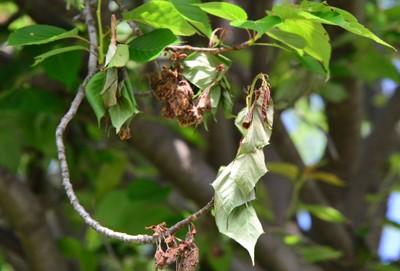Key points
- Brown rot is a fungal infection that attacks flowering cherry trees, especially the cultivar 'Kwansan' later in spring just as the flowers are starting to fade.
- This relatively new disease is really an old orchard disease of stone fruit called brown rot. In Maryland landscapes, this disease is caused by the fungus Monilinia laxa. Brown rot on fruit producing cherries is a common disease found in fruit orchards. Management in the orchard relies on good sanitation and proper timing of protectant fungicides
- The first symptoms often seen are browning and the collapse of the blossoms followed closely by the death of the small twigs.
- The symptoms look like fire blight, but cherries are not susceptible to that disease.

Brown rot symptoms. Photo: David L. Clement, University of Maryland
Disease progression
- If the infected blossoms do not drop off, the fungus can grow through the flower stem (pedicel) and into the twig below.
- Twigs develop elliptical cankers with profuse gumming at the margin between diseased and healthy tissue.
- Leaves on these infected shoots turn brown and wither, but remain attached.
- Sometimes, twigs are girdled and killed.
- During wet weather in May and June, the fungus sporulates (produces spores that spread disease) on the surface of infected twig cankers.
- Cankers enlarge from season to season, and sporulation may continue on large cankers for 4 years or more.
- In rainy weather, the appearance of powdery tufts of brown-gray spores is visible on the outside of infected flowers, infected fruit, or twig surfaces.
Management
- In ornamentals, this disease is a relatively new problem and the control has not been studied extensively.
- Pruning blighted (diseased) shoots back to healthy tissue during dry weather may help, but is difficult if there is a large number of them.
